Getting your team to work to your expectations isn’t always easy. Without clear goals, everyone can end up pulling in different directions. In fact, many employees are unclear about what is expected of them. This leads to misalignment, which holds back their productivity.
In this guide, you’ll learn 10 simple talent management strategies to help your talent stay on track and aligned with your company’s bigger picture. From setting clear objectives to using the right tools for feedback, these tips will keep everyone moving toward the same goal.
Turn confusion into clarity and stop struggling with misalignment in your team.
Key Takeaways
- Effective talent management strategies are key to improving performance, engagement, and alignment across teams.
- Measuring success involves tracking key metrics such as productivity, engagement, and goal alignment.
- OKRs provide clarity and focus, ensuring everyone is working toward shared objectives.
- Employee feedback is crucial for identifying strengths, areas for growth, and improving team morale.
- Developing internal leadership through career development boosts retention and team effectiveness.
What are Talent Management Strategies?
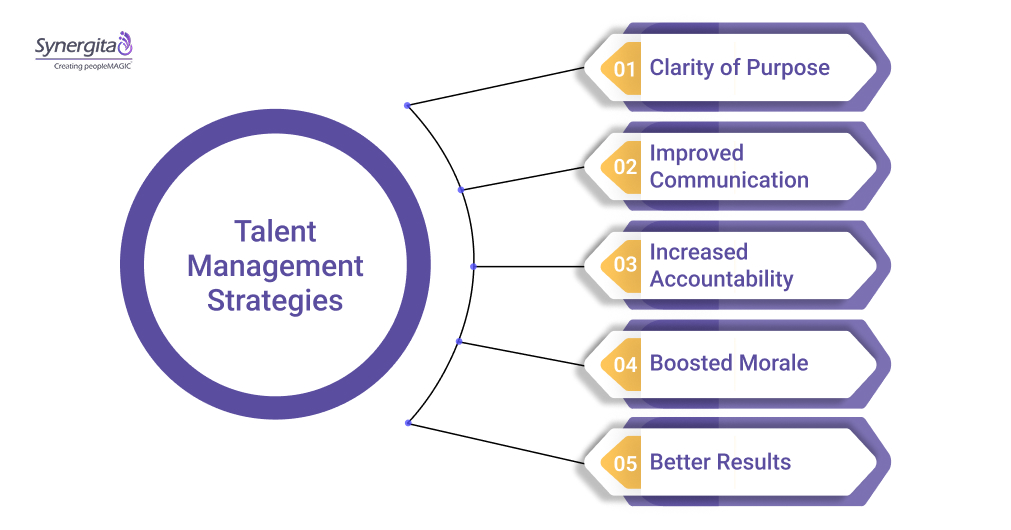
Talent management strategies are the methods and approaches leaders use to get their teams to work efficiently. These strategies ensure everyone knows what they’re working on, why it matters, and how to get there. Without them, teams can lose focus and productivity.
Here’s why they really matter:
- Clarity of Purpose: Clear strategies ensure everyone knows what they need to do and why it matters. This keeps the team aligned and focused on the bigger picture.
- Improved Communication: A well-defined strategy encourages open communication, reducing misunderstandings and promoting effective collaboration.
- Increased Accountability: With clear expectations, you know who to hold accountable.
- Boosted Morale: When teams have a clear direction, it reduces confusion and frustration, leading to more motivated team members.
- Better Results: A strategic approach helps teams stay on course, work more efficiently, and achieve goals faster.
When you invest in the right talent management strategies, the benefits are clear. However, these benefits don’t happen by chance. They’re the result of a well-structured and deliberate approach to the talent management process model.
The AARRR Talent Management Process Model

The AARRR talent management model is an effective, structured approach to optimizing talent management at each stage of the employee journey. Adapted from the Pirate Metrics framework, this model provides a comprehensive view of the key stages involved in acquiring, developing, and retaining talent.
Key stages include:
1. Acquisition
In 2025, acquiring top talent is crucial. This section explores strategies that will help you build a unique employer brand using social media to attract talent.
- Develop and promote a unique employer brand that reflects the company’s culture, values, and work environment.
- Use targeted social media campaigns to reach passive candidates and expand your talent pool.
- Build relationships with talent sources, including universities, industry conferences, and networking events.
2. Activation
Onboarding goes beyond introductions. Discover how to set clear expectations and create an environment that helps them succeed and integrate smoothly into your team.
- Provide a structured onboarding program that includes company culture, role expectations, and team integration.
- Set clear expectations and provide employees with the necessary resources and tools to succeed.
- Assign mentors or team members to help newcomers adjust to their new roles.
3. Revenue
Investing in skill development and performance management drives results. This section highlights how training, feedback, and goal alignment boost both individual and company performance.
- Promote continuous skill development through training, workshops, and learning opportunities.
- Implement regular performance management processes, providing constructive feedback and recognizing achievements.
- Align individual goals with company objectives to maintain focus and drive performance.
4. Referral
Employee referrals can bring in top talent aligned with your company values. Learn how to encourage, reward, and amplify employee referrals to build a stronger team.
- Encourage employees to refer candidates who align with the company’s values and culture.
- Reward employees for successful referrals through incentives or recognition programs.
- Use employee ambassadors to share positive company experiences on social media and professional networks.
5. Retention
Keeping talent is key to long-term success. Explore how competitive compensation, career development, and a positive work culture can help retain your best employees.
- Offer competitive compensation and benefits that align with industry standards.
- Provide career development opportunities through promotions, mentoring, and job rotation programs.
- Promote a positive work culture by encouraging open communication, providing regular feedback, and addressing employee concerns.
If you optimize each stage of the talent management process, organizations can retain top talent and drive growth and innovation.
Now that you’ve covered what the talent management model looks like, let’s understand the proven strategies. You can start using those today to ensure they are aligned with the above model.
10 Proven Talent Management Strategies to Drive Results
Managing teams can be tricky. Ensuring development and driving performance requires more than just assigning tasks. Here’s a list of 10 proven strategies that can ensure long-term success:
1. Use Talent Analytics and Workforce Data
Discover how analyzing trends and tracking performance metrics can give you the edge, enabling smarter decisions and anticipating future team needs.
- Analyze your team’s data, so you can uncover trends, track productivity, and even predict future needs.
- This data-driven approach allows you to optimize how your team works. That’s why 53% of corporate leaders are excited to invest in data-driven analytics.
- Track employee performancemetrics such as productivity, attendance, and skills.
- Identify performance gaps and create targeted strategies for improvement.
- Measure team dynamics to improve cross-department collaboration.
2. Prioritize Employee Education, Upskilling, and Reskilling
Don’t let your team fall behind. Learn how offering growth opportunities strengthens your workforce and ensures you’re ready for the challenges ahead.
- Upskilling boosts your team’s capabilities, ensuring they’re ready for the next step.
- 88% of organizationsstruggle with retention.However, reskilling is key to preparing employees for new roles within the organization.
- Providing learning opportunities helps with employee retention.
- Offering upskilling shows that you’re invested in your talent’s long-term growth.
- Use training insights to adjust upskilling efforts and measure success.
3. Develop Internal Mobility and Succession Planning
The best talent is often already in-house. This section shows you why promoting from within can keep your team strong and agile.
- Promote from within to create a culture of growth and advancement.
- Succession planning helps prepare employees for leadership roles, ensuring a smooth transition when key roles open up.
- Identify high-potential employees and prepare them to lead.
- Succession planning helps future-proof your leadership pipeline, keeping the team strong long-term.
Synergita’s holistic360-degree feedback helps get performance and development feedback from internal and external stakeholders. It allows managers to identify high-potential employees and give them the development support they need to step into leadership roles.
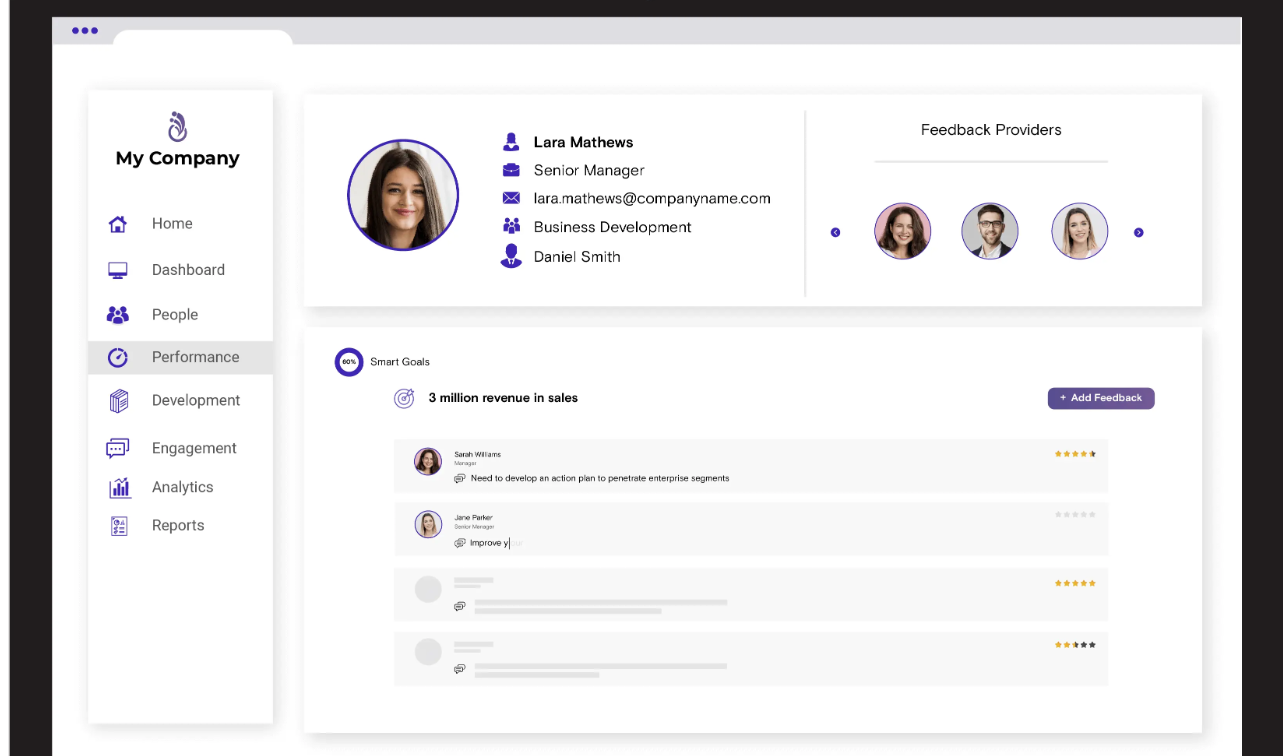
4. Enhance Employee Engagement and Retention
Struggling to keep your top performers? Discover how recognition and growth opportunities can enhance loyalty, giving you a competitive edge.
- Regular recognition and feedback improve morale and motivate employees to perform at their best.
- Businesses with engaged employees are 14% more likely to be productive.
- Providing growth opportunities enhances employee loyalty and engagement.
- Building a culture of appreciation and recognition also helps retain top talent.
- Clear communication and transparency lead to reduced turnover.
5. Expand Support for Employee Well-being and Mental Health
The future of work demands a focus on well-being. Providing mental health support and wellness programs is essential for employee retention.
- Team-building activities improve employee productivity and focus.
- Work-related stress affects productivity, so offering mental health support improves overall job satisfaction.
- Flexible schedules and wellness programs help prevent burnout.
- Teams with a focus on well-being are more engaged and committed to success.
- Employee support initiatives help reduce absenteeism and increase job satisfaction.
6. Champion Diversity, Equity, and Inclusion (DE&I)
If you’re not prioritizing this, you’re already behind. Because diversity drives innovation, and inclusion fuels creativity.
- Diversity provides agility to the team.
- Inclusive environments encourage creativity and drive innovation.
- DE&I initiatives help attract top talent from a wide range of backgrounds.
- A culture of inclusion enhances employee satisfaction and engagement.
- Equity-focused policies help retain a more diverse and loyal workforce.
7. Embrace Hybrid Work and Flexibility
Learn why hybrid models and flexible schedules are changing employee satisfaction and engagement. Figure out why companies that don’t adapt risk losing their best talent.
- Hybrid work models offer flexibility, allowing employees to work from both the office and remotely.
- Flexible work policies help reduce stress, leading to better overall well-being.
- Offering remote work options increases employee satisfaction and engagement.
- Companies that embrace hybrid work can attract a wider talent pool, including those who prefer flexible schedules.
8. Promote a Culture of Learning and Innovation
Innovation is the key to staying ahead, and it starts with your team. Skipping this might jeopardize your position as an industry leader.
- Innovation thrives when employees feel encouraged to experiment and think creatively.
- Encouraging creative problem-solving leads to faster growth and adaptability.
- Create a space where mistakes are seen as learning opportunities, not failures.
- Innovation programs can help teams develop new ideas that directly impact business goals.
Synergita allows organizations to manage skill sets effectively. Your employees can record their skill updates and career aspirations with Synergita. It helps organizations match candidates with the skills and passion necessary for open positions.
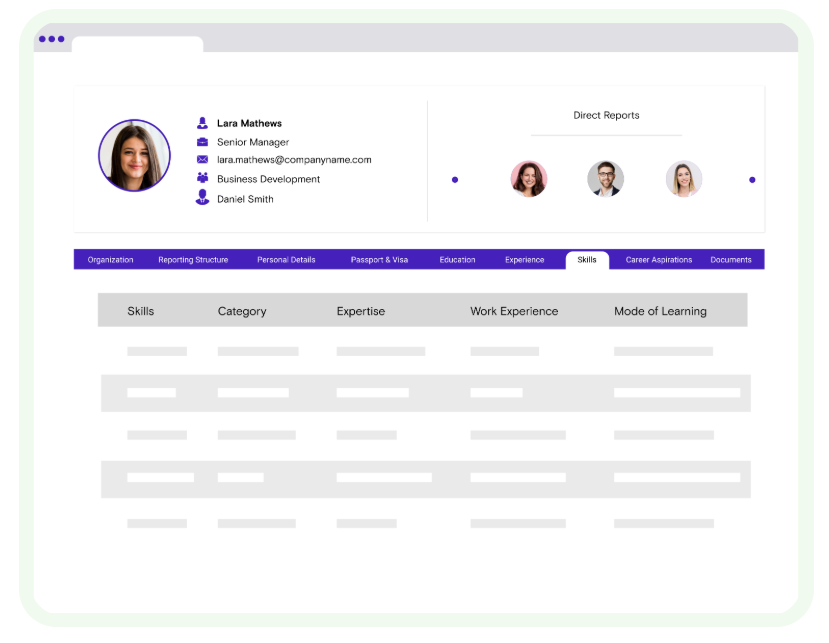
9. Utilize AI and Automation in Talent Processes
AI and automation are the pillars of talent management. These tools personalize growth like never before while hiring the best talent for your team.
- AI and automation can organize recruitment, performance management, and employee development.
- Automating repetitive tasks gives managers more time to focus on strategic decisions.
- 64% of HR professionalsreport that AI tools improve hiring efficiency.
- AI-driven insights can help predict employee success and retention.
- Automation can assist in handling large volumes of data, making HR processes faster and more efficient.
- AI tools can help personalize employee development, ensuring each team member receives the right training.
Synergita’s AI-based sentiment analysisprovides true employment perception surveys, offering real-time insights into employee emotions. This helps you decode feedback effectively, ensuring you stay in tune with employee sentiment.
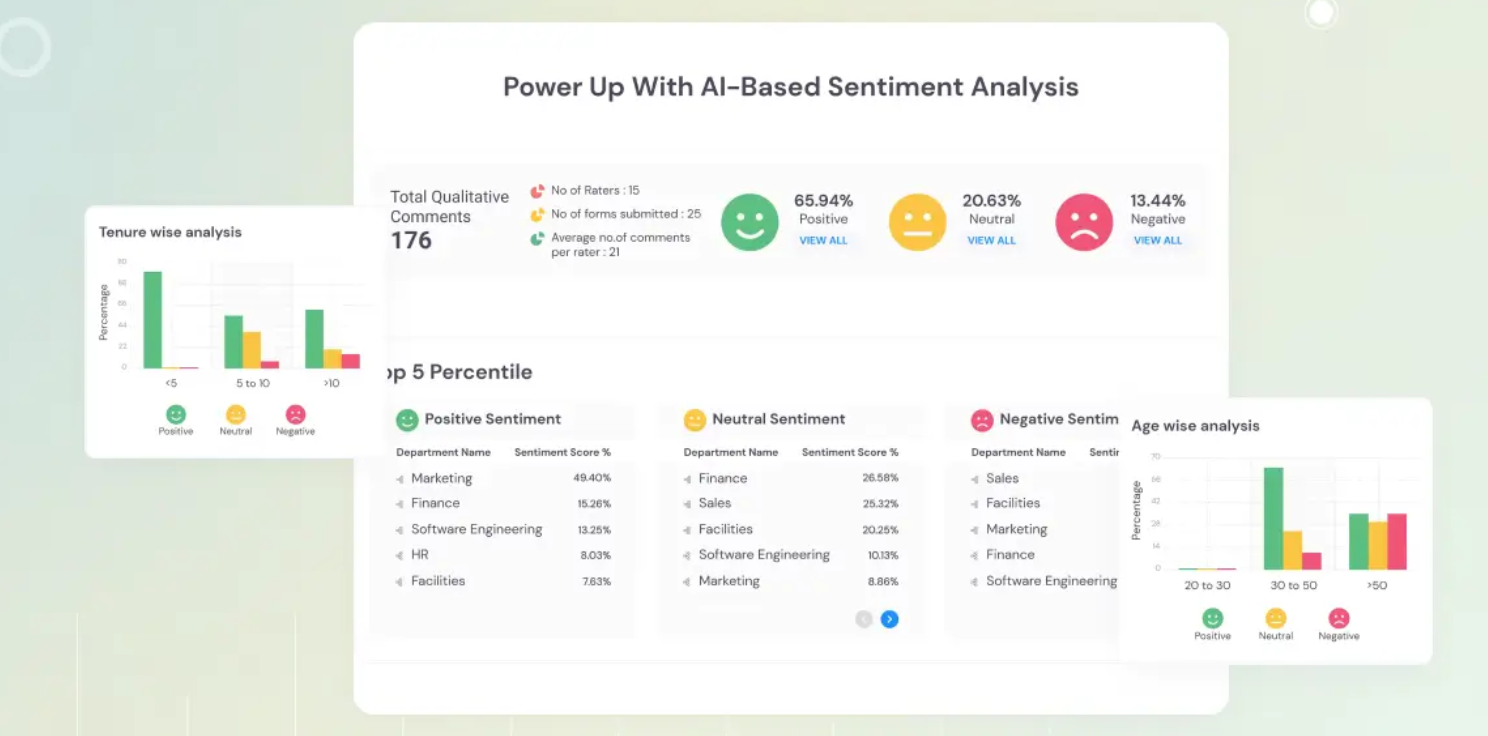
10. Build Empathetic and Inclusive Leadership
Leadership that truly listens and supports will be the difference between thriving teams and high turnover. Learn how empathetic and inclusive leadership drives collaboration.
- Empathetic leadership helps employees feel understood, valued, and supported.
- Inclusive leadership encourages diversity of thought, driving better innovation.
- Training leaders in soft skills leads to improved conflict resolution and team cohesion.
- Inclusive leaders promote an environment where everyone feels comfortable contributing their ideas.
- Empathy in leadership leads to stronger relationships and better team collaboration.
With the right tools, like Synergita, you can organize processes and create a thriving, productive team culture.
How Synergita Powers Your Talent Management Strategies?
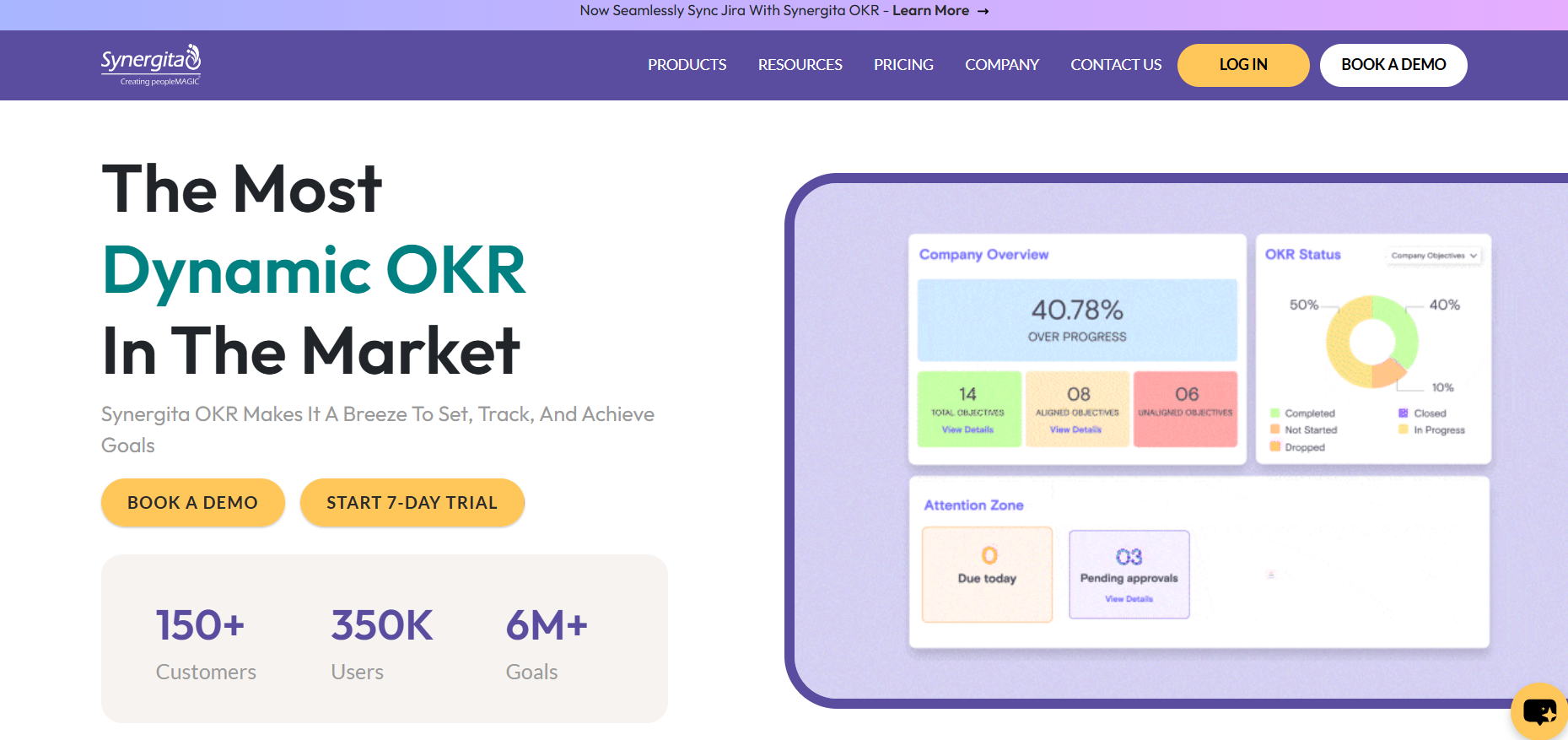
This platform is designed to help you implement and scale the talent management strategies as discussed above. With a suite of powerful tools, it enables organizations to align their teams and drive continuous growth. Here’s how your team receives benefits while using this tool:
- AI-Powered InsightsSynergita’s AI-driven analytics and NLP-based tools provide real-time insights into employee performance, engagement, and well-being. This allows managers to make data-backed decisions and track key performance indicators (KPIs) for continuous improvement.
- 360-Degree FeedbackIts holistic 360-degree feedback system ensures that managers get comprehensive feedback from every decision-maker. This helps identify leadership potential, spot skill gaps, and promote a culture of continuous development.
- Goal Setting and OKRsThis helps teams set and track goals with OKRs (Objectives and Key Results), aligning individual, team, and organizational objectives. With easy-to-use dashboards, managers can keep track of progress and ensure alignment at every level.
- Flexible Integration:
This platform integrates with popular human resources information systems (HRIS), such as Bamboo HR and Workday. You can organize workflows and synchronize data to create a unified experience.
Synergita helps you to execute these strategies with ease, so let this be your trusted partner in talent management.
Help Your Team to Achieve More
Effective talent management goes beyond assigning tasks. You need to create the right environment for your team to succeed. The discussed strategies are the key to reaching their full potential. And, if you have the right platform in hand, you are already one step ahead of your competitor.
That’s where Synergita comes in. With its powerful suite of features, it helps you miake informed decisions that lead to continuous growth in the team.
Ready to take your team to the next level? Start your free trial and turn misalignment into clarity. The right solutions are here to make it happen.
FAQs
1. How can I measure the effectiveness of my talent management strategies?
Track key metrics like employee engagement, productivity, and goal completion. Regular feedback and performance reviews can help identify areas for improvement.
2. What are the key benefits of implementing OKRs for my team?
OKRs drive alignment, focus efforts on measurable goals, and enhance transparency. They keep teams motivated by providing clear objectives and tracking progress.
3. How does employee feedback improve team performance?
Employee feedback highlights strengths and areas for improvement, promoting continuous growth. It helps identify issues early and ensures that employees feel heard and valued.
4. How can I build leadership from within my team?
Offer clear career development paths, provide regular feedback, and identify high-potential individuals for growth opportunities. Help them take on leadership responsibilities to develop their skills.



